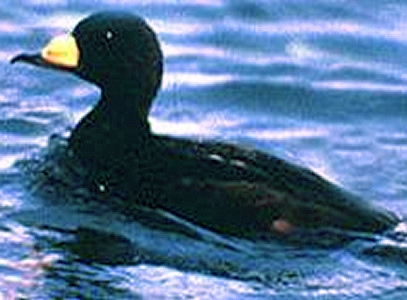Common scoter
| Common Scoter | ||||||||||||||
|---|---|---|---|---|---|---|---|---|---|---|---|---|---|---|
 | ||||||||||||||
| ' | ||||||||||||||
| ||||||||||||||
| Binomial name | ||||||||||||||
| Melanitta nigra (Linnaeus, 1758) |
The Common Scoter (Melanitta nigra) is a large sea duck, 44-54 cm in length, which breeds over the far north of Europe, Asia and North America. There are two subspecies; the American race M. n. americana, known as the Black Scoter, is sometimes given specific status.
It winters further south in temperate zones, on the coasts of the northern USA, Europe as far south as Great Britain, and Asia as far south as China. It forms large flocks on suitable coastal waters. These are tightly packed, and the birds tend to take off together. Some birds may over-winter on the Great Lakes.
The lined nest is built on the ground close to the sea, lakes or rivers, in woodland or tundra. 5-7 eggs are laid.
It is characterised by its bulky shape and large bill. The male is all black with a bulbous bill. In Black Scoter, the bill is more bulbous and more extensively yellow. The female is a brown bird with pale cheeks.
This species can be distinguished from other scoters by the lack of white anywhere on the drake, and the more extensive pale areas on the female.
This species dives for crustaceans and molluscs; it also eats aquatic insects and small fish when on fresh water.